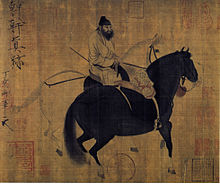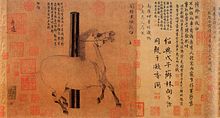 Han Gan was born in c. 706 and died in 783 CE. He was a Tang Dynasty painter who favored painting horses. He came from a poor family in either Chang'an, modern-day Xi'an, Shaanxi; Lantian, modern-day Shaanxi; or Daliang, modern-day Kaifeng, Henan. As a young man, Han Gan was recognized by Wang Wei, a prominent painter/poet of the high Tang, who sponsored Han in learning arts when "startled by the boy's talent after he observed Han Gan drawing figures in the sand with a stick. Han Gan was eventually summoned by Emperor Xuanzong to paint images of prized horses-an exotic novelty acquired from Central Asia-in order to proclaim imperial power and to memorialize these defenders of the empire..." Hán Gan/Hawks, Shelley Drake. (2014). "Han Gan." In Kerry Brown (Ed.), Berkshire dictionary of Chinese biography (pp. 489-502). Great Barrington, MA: Berkshire Publishing.
Han Gan was born in c. 706 and died in 783 CE. He was a Tang Dynasty painter who favored painting horses. He came from a poor family in either Chang'an, modern-day Xi'an, Shaanxi; Lantian, modern-day Shaanxi; or Daliang, modern-day Kaifeng, Henan. As a young man, Han Gan was recognized by Wang Wei, a prominent painter/poet of the high Tang, who sponsored Han in learning arts when "startled by the boy's talent after he observed Han Gan drawing figures in the sand with a stick. Han Gan was eventually summoned by Emperor Xuanzong to paint images of prized horses-an exotic novelty acquired from Central Asia-in order to proclaim imperial power and to memorialize these defenders of the empire..." Hán Gan/Hawks, Shelley Drake. (2014). "Han Gan." In Kerry Brown (Ed.), Berkshire dictionary of Chinese biography (pp. 489-502). Great Barrington, MA: Berkshire Publishing. ![]() Han became a student of Cao Ba a court painter. After his studies, Han became a painter in the Tang court. Cao Ba/Chinese Painting/Encyclopedia Britannica
Han became a student of Cao Ba a court painter. After his studies, Han became a painter in the Tang court. Cao Ba/Chinese Painting/Encyclopedia Britannica ![]() ["...The other great horse-painting master was the army general Cao Ba, said by the poet Du Fu to have captured better the inner character of his subjects and not just the flesh. Most later horse painters claimed to follow Han Gan or Cao Ba, but the actual stylistic contrast between them was already reported in Bei (Northern) Song times as no longer distinguishable and today is hardly understood. ..."]
["...The other great horse-painting master was the army general Cao Ba, said by the poet Du Fu to have captured better the inner character of his subjects and not just the flesh. Most later horse painters claimed to follow Han Gan or Cao Ba, but the actual stylistic contrast between them was already reported in Bei (Northern) Song times as no longer distinguishable and today is hardly understood. ..."]
 The image to the left is entitled Night-Shining White and is his most famous painting. "...a favorite charger of the emperor Xuanzong (r. 712-56). The fiery-tempered steed, with its burning eye, flaring nostrils, and dancing hooves, epitomizes Chinese myths about imported 'celestial steeds' that 'sweat blood' and were really dragons in disguise. This sensitive, precise drawing, reinforced by delicate ink shading, is an example of baihua (white painting), a term used in Tang texts to describe monochrome painting with ink shading, as opposed to full color painting. The later term baimiao (white drawing) denotes line drawing without shading..." Night-Shining White
The image to the left is entitled Night-Shining White and is his most famous painting. "...a favorite charger of the emperor Xuanzong (r. 712-56). The fiery-tempered steed, with its burning eye, flaring nostrils, and dancing hooves, epitomizes Chinese myths about imported 'celestial steeds' that 'sweat blood' and were really dragons in disguise. This sensitive, precise drawing, reinforced by delicate ink shading, is an example of baihua (white painting), a term used in Tang texts to describe monochrome painting with ink shading, as opposed to full color painting. The later term baimiao (white drawing) denotes line drawing without shading..." Night-Shining White ![]() Han painted many portraits and Buddhistic themed paintings during his career; however, he is most widely remembered for his paintings of horses. He was reputed to be able to not only portray the physical body of the horse, but also its spirit. His reputation rose and surpassed that of his teacher. Horse painters of later generations studied Han. He is honored with a crater named for him on Mercury.
Han painted many portraits and Buddhistic themed paintings during his career; however, he is most widely remembered for his paintings of horses. He was reputed to be able to not only portray the physical body of the horse, but also its spirit. His reputation rose and surpassed that of his teacher. Horse painters of later generations studied Han. He is honored with a crater named for him on Mercury. ![]() Han Gan
Han Gan ![]()
For More Information:
Han Gan - Tang DynastyChinese Painting/Encyclopedia Britannica

